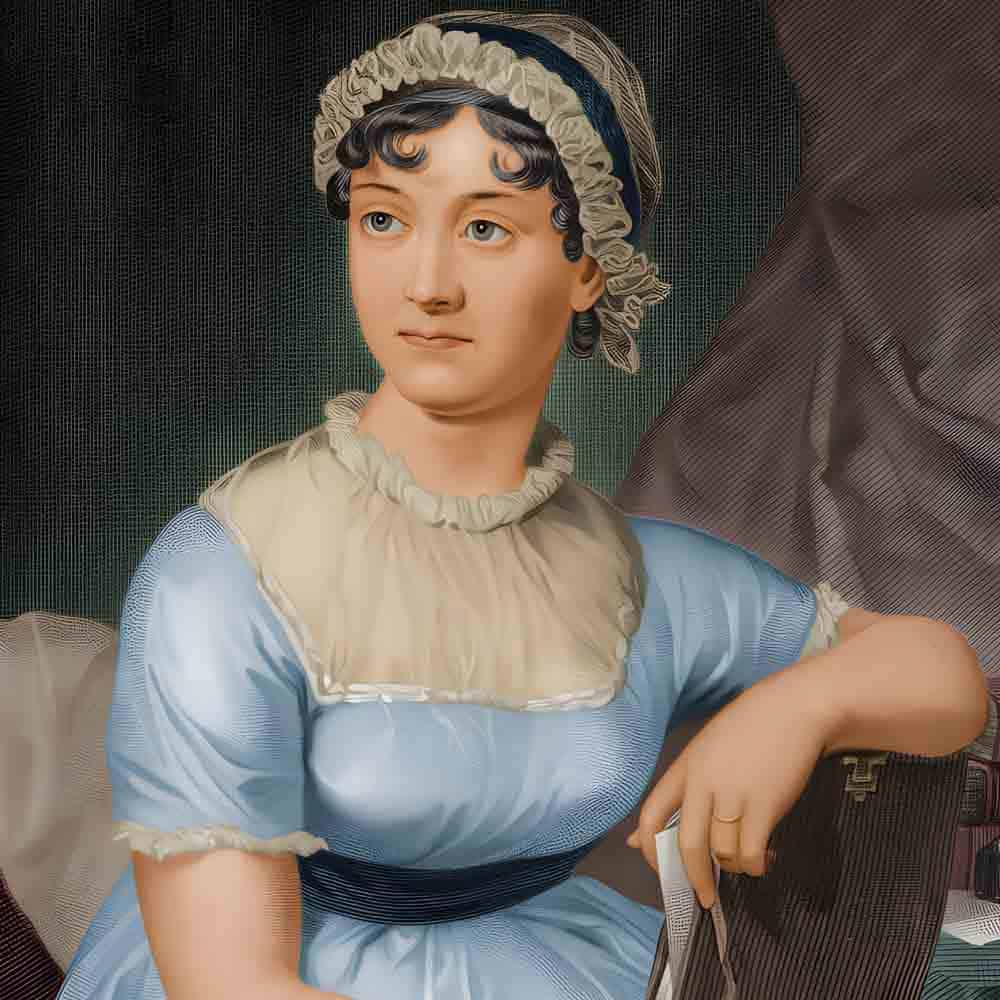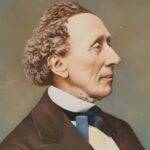
Jane Austen: Unveiling the Timeless Appeal of Her Classic Novels
Born: 16 December 1775
Died: 18 July 1817
Country: England
Notable works: Sense and Sensibility, Pride and Prejudice, Mansfield Park, Emma, Northanger Abbey, Persuasion
Jane Austen stands as one of the most celebrated English novelists of the late 18th and early 19th centuries. Her acute observations and sharp wit rendered her works timeless, and her novels continue to be read and admired for their social commentary and insight into the human experience. Austen’s fiction often revolves around the lives of young women navigating the marriage market of early 19th century England, portraying the dependencies and restrictions they faced due to their societal status.
Her writing style, characterized by its irony and realism, offers a window into the British landed gentry of her time. Austen’s novels, such as Pride and Prejudice, Sense and Sensibility, and Emma, delve into themes of love, reputation, and class, providing astute critiques of the social structures that dictated personal relationships and social mobility. Through her portrayal of complex characters and their interactions, Austen’s works highlight the importance of virtue and moral character.
Though published more than two centuries ago, Austen’s novels retain a sense of immediacy that resonates with contemporary readers. Her storytelling exhibits a keen understanding of human behavior, ensuring her place in the literary canon. The longevity of her work is a testament to her skill in marrying entertainment with thoughtful social examination, earning her a cherished position in English literature.
1. Early Life and Family
Jane Austen’s early years were deeply influenced by her upbringing in a supportive family, her diverse education that fostered her burgeoning literary talent, and the pastoral beauty of the English countryside that she called home.
1.1. Born in Steventon
On December 16, 1775, in Steventon, Hampshire, England, Jane Austen was born to George and Cassandra Austen. The family’s rectory in Steventon, surrounded by the Hampshire countryside, was Austen’s home for the initial 25 years of her life, offering a serene backdrop for her early writing endeavors.
1.2. Close-Knit Family
Within a large, close-knit family framework, including her parents and seven siblings, Austen’s bond with her sister Cassandra was notably strong, serving as a lifelong friendship and source of support. This familial environment was pivotal in her development as a writer, providing a rich intellectual atmosphere that nurtured her early literary experiments.
1.3. Education and Early Writing
The Austen children’s education, primarily overseen at home by their father, was complemented by Jane’s attendance at schools in Oxford, Southampton, and the Abbey School in Reading, albeit for relatively short periods. These experiences, combined with extensive reading from her father’s library, constituted a comprehensive educational foundation. Jane’s early forays into writing, encompassed in her Juvenilia, include short stories, plays, and poems that entertained her family. These early works, characterized by their parody, satire, and keen observation of human nature, foreshadowed the nuanced narratives and literary mastery that would define her celebrated novels.
1.4. Family Support
Beyond intellectual stimulation, Austen’s family played a crucial role in her literary career, with her brother Henry notably acting as a liaison with publishers. The financial and moral encouragement from her family was essential, enabling her to pursue her writing in a time when female authors faced significant barriers.
Through these reflections on Jane Austen’s formative years, it becomes clear how her familial bonds, educational experiences, and the serene countryside of her upbringing collectively shaped the literary genius whose works continue to enchant readers worldwide.
2. Literary Career
Jane Austen’s literary career is a testament to her enduring appeal and critical acclaim, marked by a nuanced journey from anonymity to posthumous fame as a linchpin of English literature.
2.1. First Publications
Austen’s venture into the published world commenced with Sense and Sensibility (1811), swiftly followed by Pride and Prejudice (1813), both of which were initially released anonymously under the designation “A Lady”. These early works, published on commission – a testament to Austen’s determination and the financial risks she undertook – were facilitated by Thomas Egerton, a publisher receptive to new authors. Pride and Prejudice quickly endeared itself to readers, foreshadowing the significant stature Austen would posthumously achieve. These publications laid the groundwork for her career, showcasing her adeptness at social commentary and complex character portrayal.
2.2. Critical Reception
In her lifetime, Austen’s novels garnered appreciation from a broad readership, including the aristocracy, with Emma (1815) notably dedicated to the Prince Regent at his librarian’s suggestion, despite Austen’s reservations. While contemporary reviews acknowledged her novels’ merits, particularly her character development and social critique, Austen’s broader recognition and the association of her works with the term “masterpiece” emerged more fully after her passing.
2.3. Posthumous Recognition
Austen’s ascent to literary prominence accelerated with the posthumous revelation of her authorship. A Memoir of Jane Austen (1869), penned by her nephew James Edward Austen-Leigh, played a pivotal role in enhancing her reputation, albeit by projecting a somewhat idealized image that later scholarship sought to recalibrate. This memoir was instrumental in popularizing Austen, albeit framing her in a somewhat domesticated light that contrasts with the incisive observations found in her novels.
3. Major Novels
Jane Austen’s major novels explore themes of romance, societal norms, and economic security with a nuanced sense of realism. They primarily focus on the lives of the land gentry and their quest for marriage and social standing.
Sense and Sensibility
Published: 1811
Protagonists: Elinor and Marianne Dashwood
Themes: Economic Security, Romance, Social Conduct
Sense and Sensibility tells the story of the Dashwood sisters, Elinor and Marianne, contrasting their responses to love and adversity. It addresses the necessity of marrying for economic security while balancing societal expectations and personal desires.
Pride and Prejudice
Originally Titled: First Impressions
Published: 1813
Protagonists: Elizabeth Bennet, Mr. Darcy
Key Themes: Marriage, Wealth, Social Hierarchy
Elizabeth Bennet’s spirited demeanor challenges the social norms of the time through her interactions with the wealthy and aloof Mr. Darcy. Pride and Prejudice examines the impacts of first impressions and the significance of marriage and wealth among the gentry.
Mansfield Park
Published: 1814
Protagonist: Fanny Price
Focus: Morality, Social Order, Upward Mobility
In Mansfield Park, Fanny Price navigates the intricate social ladder of the Bertram family estate. The novel delves into the complex dynamics between family, social expectations, and personal integrity.
Emma
Published: 1815
Protagonist: Emma Woodhouse
Central Themes: Matchmaking, Self-Deception, Social Status
Emma Woodhouse, a well-meaning but misguided matchmaker, comes to terms with her romantic feelings amidst her endeavors to arrange others’ lives. The novel is a commentary on the perils of misconstrued romance and the social standings of the landed classes.
Persuasion
Published: 1817 (posthumously)
Protagonist: Anne Elliot
Key Elements: Regret, Second Chances, Autonomy
Persuasion revolves around Anne Elliot’s personal growth and her rekindled romance with Captain Wentworth after a broken engagement. The narrative spotlights themes such as the repercussions of persuasion and the pursuit of happiness over societal expectations.
Northanger Abbey
Published: 1817 (posthumously)
Protagonist: Catherine Morland
Highlighted Aspects: Satire, Gothic Novel Parody, Youth
Catherine Morland’s experiences in Northanger Abbey satirize the thrills of gothic novels contrasted with her much more ordinary reality. The novel humorously critiques the fantastical imaginations of the young and naive in the context of their social milieu.
4. Themes and Style
Jane Austen’s novels, celebrated for their sharp commentary on the marriage market and social stratification of the Regency era, showcase an exceptional blend of romantic narratives and classical rationality, punctuated with a distinctive realism.
4.1. Social Class and Marriage
At the heart of Austen’s oeuvre is the critical interplay between social class and marriage. Her heroines deftly navigate the intricate societal web, where marriage emerges as a vital avenue to economic stability for women. Austen’s portrayal of marriage transcends the simplistic dichotomy of romantic union versus socioeconomic strategy. Instead, her stories often culminate in unions that harmonize romantic affection with prudent economic considerations, suggesting a nuanced belief in the attainability of both personal happiness and financial security within the constraints of gentry life.
- Economic considerations and marital alliances are portrayed with complexity, highlighting Austen’s nuanced understanding of marriage as both a personal and economic union.
- Her narratives wrestle with the dilemma of love versus social advancement, enriching her characters’ journeys toward self-awareness and fulfillment.
4.2. Realism in Depiction
Austen’s narrative realm is distinguished by its realism, presenting the quotidian lives of her characters and their milieus with an authenticity that sets her apart from the novels of sensibility that preceded her era. Her pioneering use of free indirect speech brings characters’ thoughts and emotions to the forefront, enhancing the realism of her social portrayals. This methodological choice not only provides insight into the characters’ inner worlds but also deepens the thematic exploration of internal conflicts and moral choices, grounding her narratives in a palpable reality.
Her detailed focus on social interactions and the lifeways of the English gentry is coupled with a keen observation of internal dilemmas and ethical considerations.
4.3. Romantic Versus Classical
Navigating the currents between romantic emotionalism and classical decorum, Jane Austen forges a narrative style that is both deeply felt and critically observant. While her novels resonate with the personal and emotional depth characteristic of Romantic literature, they are firmly anchored by a classical adherence to societal critique and moral evaluation. This synthesis allows Austen to critique romantic idealism through a lens of classical pragmatism, embedding rich social commentary within the arcs of character development and plot evolution.
Austen’s work transcends simple categorization, employing irony and humor alongside moral scrutiny to affirm and question the social and individual values of her period.
5. Jane Austen Later Years and Death
In her final years, Jane Austen resided in Chawton, where she experienced a prolific phase of writing and revision, culminating in her passing in Winchester at the tender age of 41.
5.1. Final Works and Sanditon
While at Chawton Cottage, Austen engaged in the revision of her earlier manuscripts, with Sense and Sensibility and Pride and Prejudice having been published before her move. It was here she completed Emma and Persuasion, her novels that solidified her literary legacy. Her final, unfinished work, Sanditon, marked a nuanced continuation of her exploration into English society, this time through the lens of a burgeoning seaside resort. Despite its incomplete state, Sanditon reflects Austen’s evolving narrative style and thematic interests, including health, class, and societal change.
5.2. Illness and Death
The decline in Jane Austen’s health, suspected by some to be Addison’s disease and by others to suggest conditions such as Hodgkin’s lymphoma, became pronounced in early 1816. The specifics of her illness remain a topic of scholarly speculation. In May 1817, seeking medical intervention, she moved to Winchester. Despite medical efforts, Austen succumbed to her illness on July 18, 1817. Her final resting place is in Winchester Cathedral, a testament to her enduring influence on English literature and the deep affection held for her work.
6. Legacy and Adaptations
Jane Austen’s enduring legacy is evident in the persistent academic interest in her works, the devotion of self-styled ‘Janeites,’ and the continuous stream of adaptations in film, television, and other forms of media. Her novels have transcended time, significantly influencing the genre of romantic fiction and establishing her reputation as a professional writer.
6.1. Continued Popularity
Austen’s novels have never gone out of print, which is a testament to their ongoing appeal. The community of “Janeites,” dedicated enthusiasts of Austen’s work, plays a significant role in maintaining her relevance in contemporary culture. Academics continue to study her contribution to literature, often focusing on themes of love, social standing, and morality.
6.2. Film and Television
Austen’s novels have been translated into cinematic experiences numerous times, appealing to a wide range of audiences. Here’s a brief overview of some notable adaptations:
- Pride and Prejudice (1995) – A critically acclaimed television series starring Colin Firth and Jennifer Ehle.
- Sense and Sensibility (1995) – An Oscar-winning film adaptation directed by Ang Lee, with Emma Thompson and Kate Winslet.
- Emma (1996) – Featuring Gwyneth Paltrow, this adaptation showcases the comedic elements of Austen’s work.
The success of these adaptations underscores Austen’s significant influence on film and television, bringing her stories to a broader audience and bridging the gap between classic texts and modern entertainment.
6.3. Literary Influence
Jane Austen has shaped the landscape of romantic fiction, setting a blueprint that has been followed by generations of writers. Her narrative style, characterized by its wit and social commentary, has inspired countless authors and found its way into their works. Her influence is not limited to English literature; her novels have been translated into many languages, making her a truly global literary figure.
Austen’s role as a professional writer has been particularly empowering for women in the literary field, serving as an early example of female authorship during a time when the profession was dominated by men.




